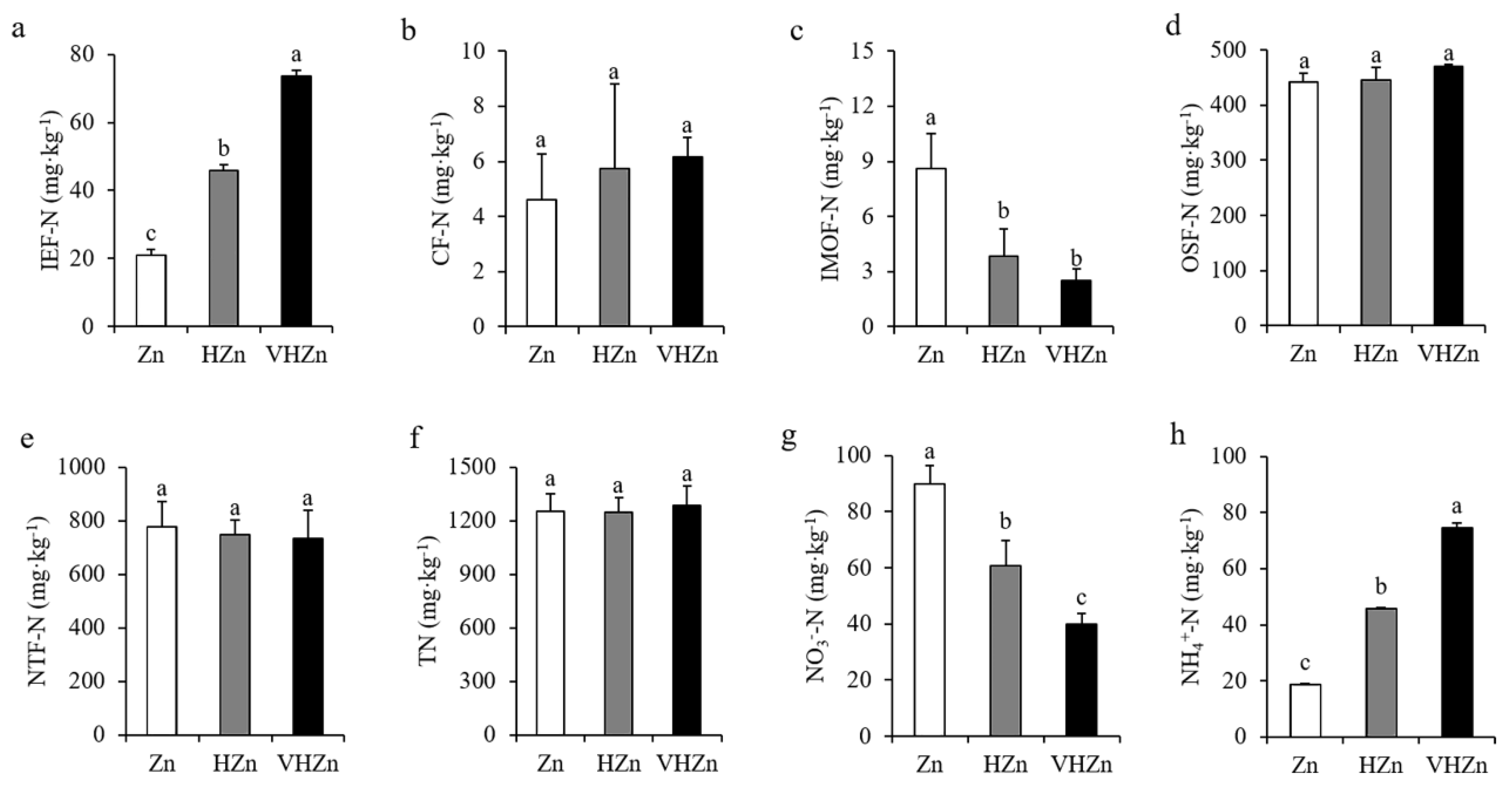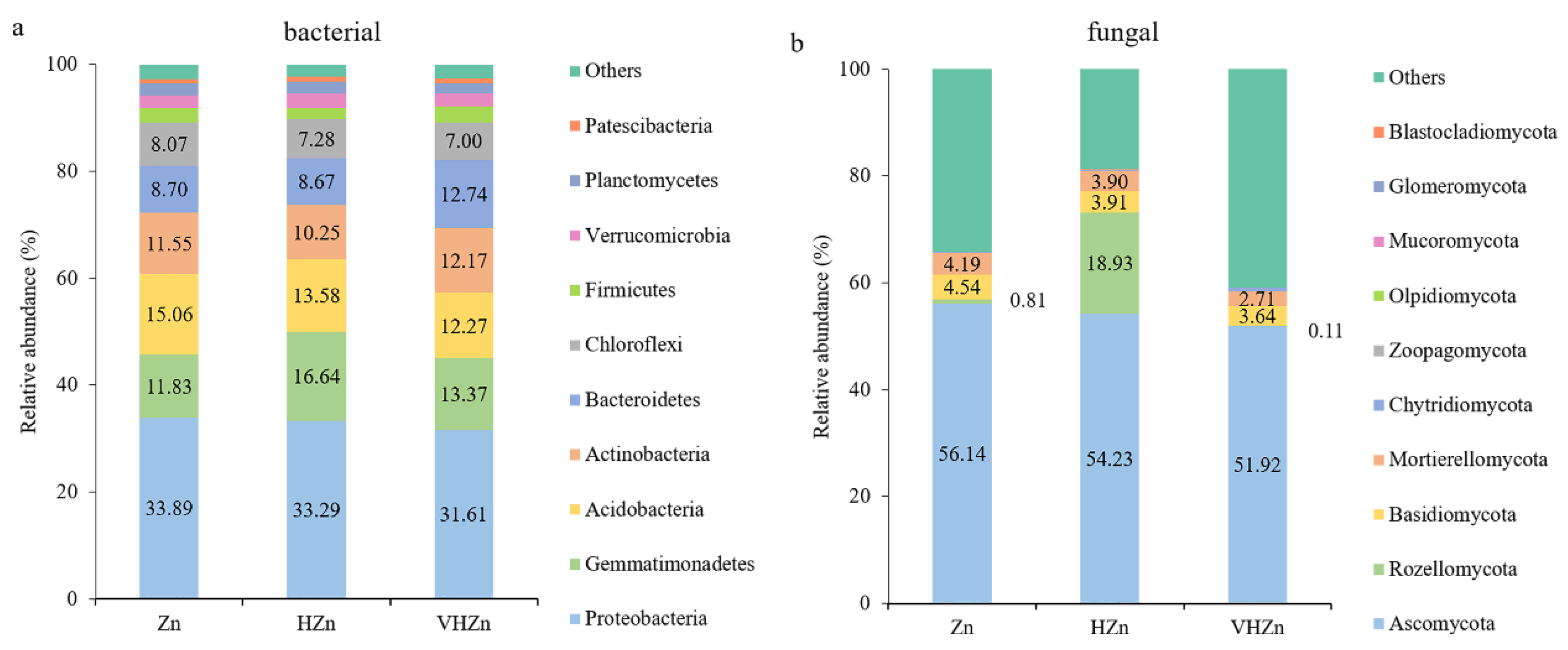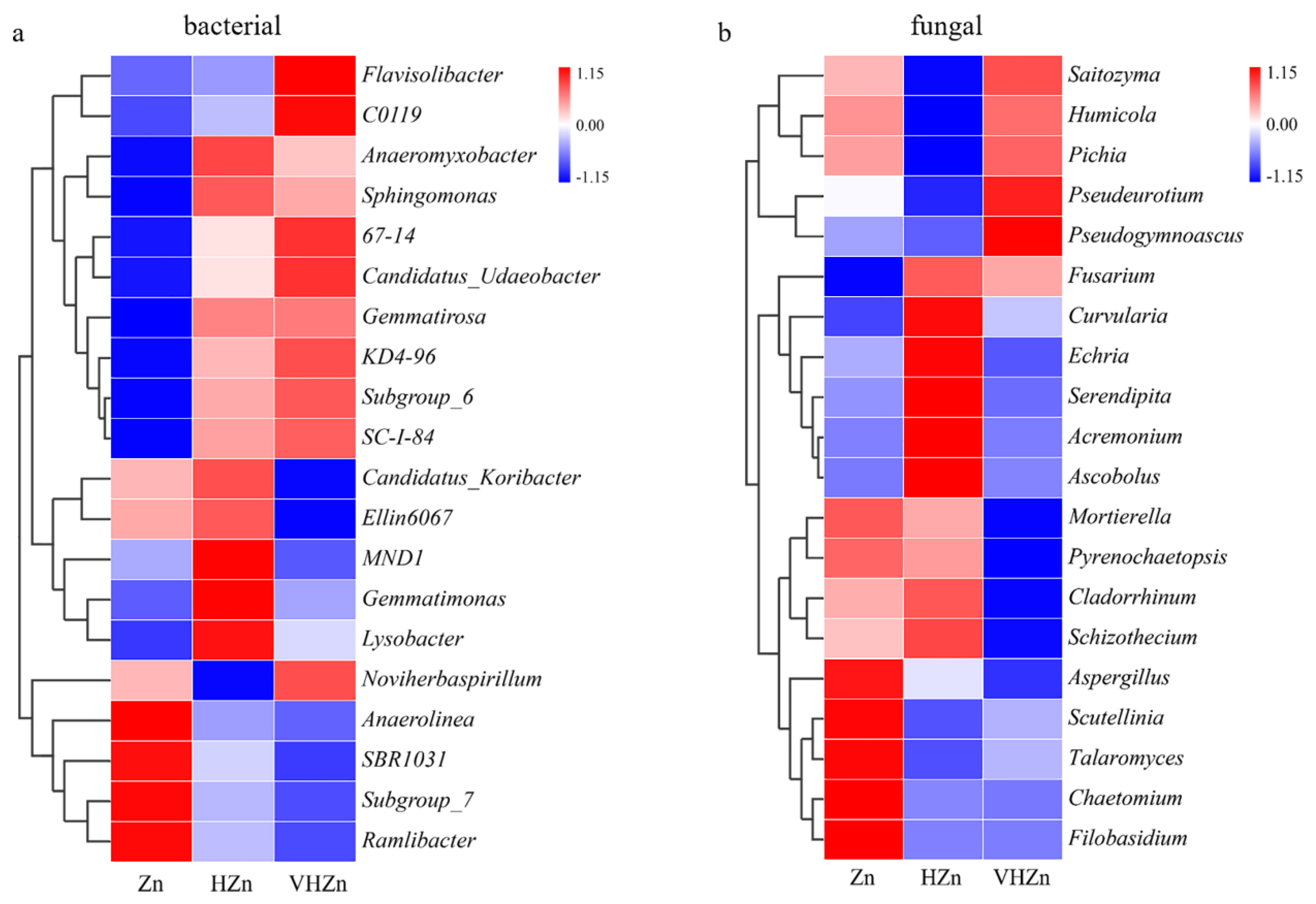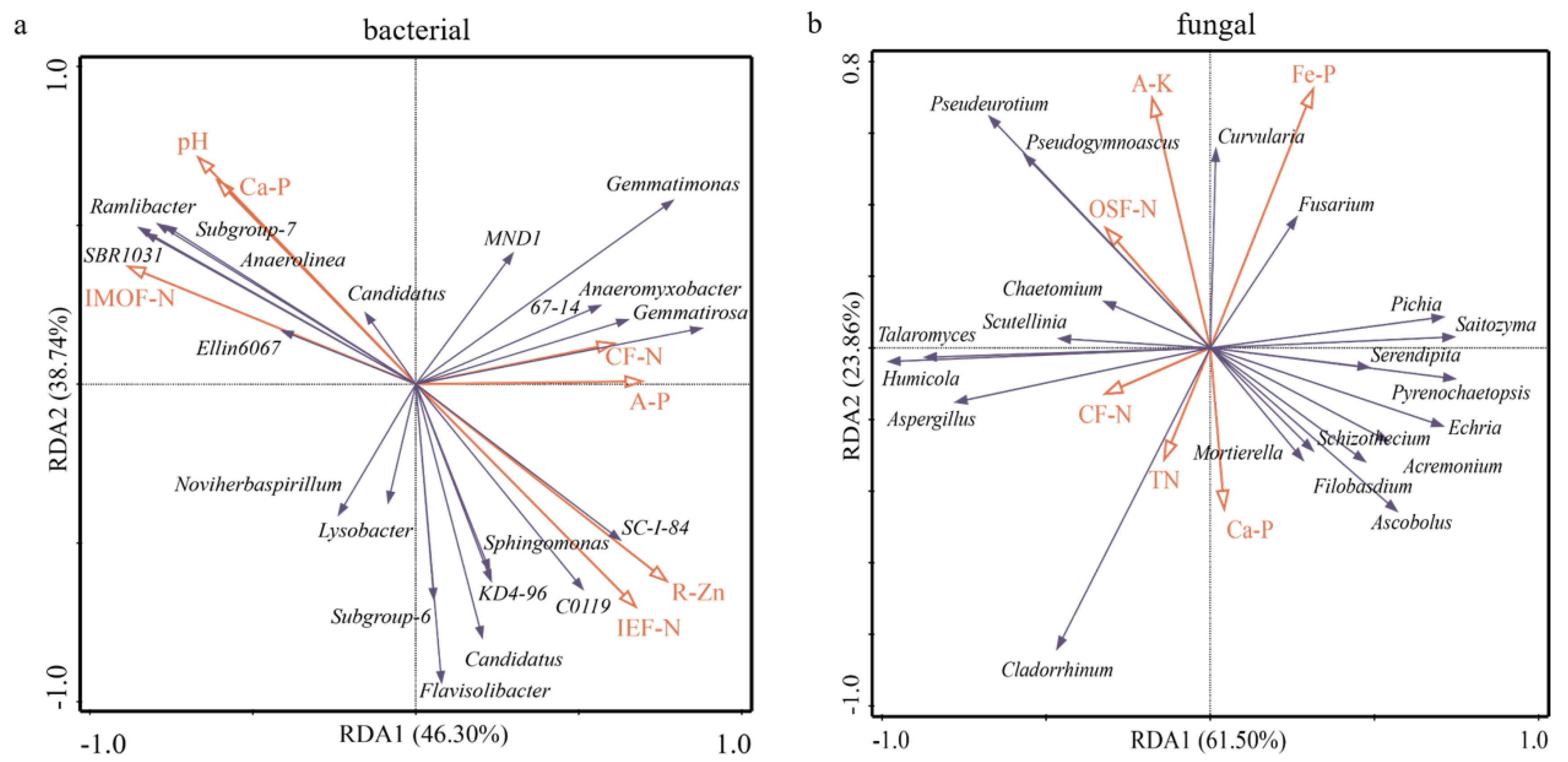High Levels of Zinc Affect Nitrogen and Phosphorus Transformation in Rice Rhizosphere Soil by Modifying Microbial Communities
Abstract
:1. Introduction
2. Results
2.1. Plant Growth and Nutrient Uptake of Rice
2.2. Basic Chemical Properties of Rice Rhizosphere Soil
2.3. Different Forms of N and P in Rice Rhizosphere Soil
2.4. Enzyme Activities in Rice Rhizosphere Soil
2.5. Bacterial Communities in Rice Rhizosphere Soil
2.6. Fungal Communities in Rice Rhizosphere Soil
2.7. Correlations between Microbial Communities and Soil Characteristics
3. Discussion
3.1. High Levels of Zn Improved N Availability in Rice Rhizosphere Soil
3.2. High Levels of Zn Promoted the Conversion of Organic P into Inorganic P
3.3. High Levels of Zn Altered Enzyme Activities in Rice Rhizosphere Soil
3.4. High Levels of Zn Modified the Bacterial and Fungi Communities
4. Materials and Methods
4.1. Plant Materials and Growth Conditions
4.2. Determination of N, P and Zn in Plant Samples
4.3. Analyses of Chemical Properties and Enzyme Activities in Soil Samples
4.4. DNA Extraction and Microbial Community Analysis of Soil Samples
4.5. Statistical Analysis
5. Conclusions
Supplementary Materials
Author Contributions
Funding
Institutional Review Board Statement
Informed Consent Statement
Data Availability Statement
Acknowledgments
Conflicts of Interest
References
- Bi, X.; Feng, X.; Yang, Y.; Qiu, G.; Li, G.; Li, F.; Liu, T.; Fu, Z.; Jin, Z. Environmental contamination of heavy metals from zinc smelting areas in Hezhang County, western Guizhou, China. Environ. Int. 2006, 32, 883–890. [Google Scholar] [CrossRef]
- Shi, T.; Ma, J.; Zhang, Y.; Liu, C.; Hua, Y.; Gong, Y.; Wu, X.; Ju, T.; Hou, H.; Zhao, L. Status of lead accumulation in agricultural soils across China (1979–2016). Environ. Int. 2019, 129, 35–41. [Google Scholar] [CrossRef] [PubMed]
- Li, X.; Zhou, Y.; Zhang, J. Status and associated human health risk of zinc accumulation in agricultural soils across China. Process Saf. Environ. 2021, 146, 867–876. [Google Scholar] [CrossRef]
- Jaworska, H.; Dabkowska-Naskret, H. Influence of the Glogow copper works on the content of mobile forms of copper and zinc in arable soils. J. Elem. 2012, 17, 57–66. [Google Scholar] [CrossRef]
- Wan, Y.; Jiang, B.; Wei, D.; Ma, Y. Ecological criteria for zinc in Chinese soil as affected by soil properties. Ecotoxic. Environ. Saf. 2020, 194, 110418. [Google Scholar] [CrossRef] [PubMed]
- Sienkiewicz, S.; Czarnecka, M.H. Content of available Cu, Zn and Mn in soil amended with municipal sewage sludge. J. Elem. 2012, 17, 649–657. [Google Scholar] [CrossRef]
- Dumoulin, D.; Billon, G.; Proix, N.; Frerot, H.; Pauwels, M.; Saumitou-Laprade, P. Impact of a zinc processing factory on surrounding surficial soil contamination. J. Geochem. Explor. 2017, 172, 142–150. [Google Scholar] [CrossRef]
- Sonoda, K.; Hashimoto, Y.; Wang, S.-L.; Ban, T. Copper and zinc in vineyard and orchard soils at millimeter vertical resolution. Sci. Total Environ. 2019, 689, 958–962. [Google Scholar] [CrossRef]
- Nagajyoti, P.C.; Lee, K.D.; Sreekanth, T.V.M. Heavy metals, occurrence, and toxicity for plants: A review. Environ. Chem. Lett. 2010, 8, 199–216. [Google Scholar] [CrossRef]
- Moffett, B.F.; Nicholson, F.A.; Uwakwe, N.C.; Chambers, B.J.; Harris, J.; Hill, T.C.J. Zinc contamination decreases the bacterial diversity of agricultural soil. FEMS Microbiol. Ecol. 2003, 43, 13–19. [Google Scholar] [CrossRef]
- Loc, K.; Janssen, C.R. Influence of soil zinc concentrations on zinc sensitivity and functional diversity of microbial communities. Environ. Pollut. 2005, 136, 275–281. [Google Scholar] [CrossRef] [PubMed]
- Ruyters, S.; Mertens, J.; Springael, D.; Smolders, E. Stimulated activity of the soil nitrifying community accelerates community adaptation to Zn stress. Soil Biol. Biochem. 2010, 42, 766–772. [Google Scholar] [CrossRef]
- Borowik, A.; Wyszkowska, J.; Kucharski, J.; Bacmaga, M.; Tomkiel, M. Pressure exerted by zinc on the nitrification process. J. Elem. 2014, 19, 327–338. [Google Scholar] [CrossRef]
- Crawford, N.M.; Forde, B.G. Molecular and developmental biology of inorganic nitrogen nutrition. In The Arabidopsis Book; American Society of Plant Biologists: Rockville, MD, USA, 2002; Volume 1, p. e1. [Google Scholar]
- Plaxton, W.C.; Lambers, H. Phosphorus metabolism in plants. Annu. Plant Rev. 2015, 48, 3–15. [Google Scholar]
- Khan, F.; Khan, S.; Fahad, S.; Faisal, S.; Hussain, S.; Ali, S.; Ali, A. Effect of different levels of nitrogen and phosphorus on the phenology and yield of maize varieties. Amer. J. Plant Sci. 2014, 5, 2582–2590. [Google Scholar] [CrossRef]
- Zhang, X.; Davidson, E.A.; Mauzerall, D.L.; Searchinger, T.D.; Dumas, P.; Shen, Y. Managing nitrogen for sustainable development. Nature 2015, 528, 51. [Google Scholar] [CrossRef]
- Knops, J.M.H.; Bradley, K.L.; Wedin, D.A. Mechanisms of plant species impacts on ecosystem nitrogen cycling. Ecol. Lett. 2002, 5, 454–466. [Google Scholar] [CrossRef]
- Carey, C.J.; Dove, N.C.; Beman, J.M.; Hart, S.C.; Aronson, E.L. Meta-analysis reveals ammonia-oxidizing bacteria respond more strongly to nitrogen addition than ammonia-oxidizing archaea. Soil Biol. Biochem. 2016, 99, 158–166. [Google Scholar] [CrossRef]
- Ouyang, Y.; Evans, S.E.; Friesen, M.L.; Tiemann, L.K. Effect of nitrogen fertilization on the abundance of nitrogen cycling genes in agricultural soils: A meta-analysis of field studies. Soil Biol. Biochem. 2018, 127, 71–78. [Google Scholar] [CrossRef]
- Fontaine, S.; Henault, C.; Aamor, A.; Bdioui, N.; Bloor, J.; Maire, V.; Mary, B.; Revaillot, S.; Maron, P.A. Fungi mediate long term sequestration of carbon and nitrogen in soil through their priming effect. Soil Biol. Biochem. 2011, 43, 86–96. [Google Scholar] [CrossRef]
- Alori, E.T.; Glick, B.R.; Babalola, O.O. Microbial phosphorus solubilization and its potential for use in sustainable agriculture. Front. Microbiol. 2017, 8, 971. [Google Scholar] [CrossRef] [PubMed] [Green Version]
- Zhang, L.; Feng, G.; Declerck, S. Signal beyond nutrient, fructose, exuded by an arbuscular mycorrhizal fungus triggers phytate mineralization by a phosphate solubilizing bacterium. ISME J. 2018, 12, 2339–2351. [Google Scholar] [CrossRef]
- Eickhout, B.; Bouwman, A.F.; van Zeijts, H. The role of nitrogen in world food production and environmental sustainability. Agric. Ecosyst. Environ. 2006, 116, 4–14. [Google Scholar] [CrossRef]
- Glass, J.B.; Orphan, V.J. Trace metal requirements for microbial enzymes involved in the production and consumption of methane and nitrous oxide. Front. Microbiol. 2012, 3, 61. [Google Scholar] [CrossRef]
- Wang, M.Y.; Siddiqi, M.Y.; Ruth, T.J.; Glass, A.D. Ammonium uptake by rice roots (II. Kinetics of 13NH4+ influx across the plasmalemma). Plant Physiol. 1993, 103, 1259–1267. [Google Scholar] [CrossRef] [PubMed]
- Kant, S.; Bi, Y.M.; Rothstein, S.J. Understanding plant response to nitrogen limitation for the improvement of crop nitrogen use efficiency. J. Exp. Bot. 2011, 62, 1499–1509. [Google Scholar] [CrossRef]
- Tiessen, H.; Moir, J.O. Characterization of available P by sequential extraction. In Soil Sampling and Methods of Analysis, 2nd ed.; Carter, M.R., Gregorich, E.G., Eds.; CRC Press: Boca Raton, FL, USA, 2007. [Google Scholar]
- Condron, L.M.; Newman, S. Revisiting the fundamentals of phosphorus fractionation of sediments and soils. J. Soils Sedi. 2011, 11, 830–840. [Google Scholar] [CrossRef]
- Condron, L.M.; Turner, B.L.; Cade-Menun, B.J. Chemistry and dynamics of soil organic phosphorus. In Phosphorus: Agriculture and the Environment; Sims, J.T., Sharpley, A.N., Eds.; SSSA: Baltimore, MD, USA, 2005; pp. 87–121. [Google Scholar]
- Prakash, D.; Benbi, D.K.; Saroa, G.S. Land-use effects on phosphorus fractions in Indo-Gangetic alluvial soils. Agrofor. Syst. 2018, 92, 437–448. [Google Scholar] [CrossRef]
- Burns, R.G.; DeForest, J.L.; Marxsen, J.; Sinsabaugh, R.L.; Stromberger, M.E.; Wallenstein, M.D.; Weintraub, M.N.; Zoppini, A. Soil enzymes in a changing environment: Current knowledge and future directions. Soil Biol. Biochem. 2013, 58, 216–234. [Google Scholar] [CrossRef]
- Rao, M.A.; Scelza, R.; Acevedo, F.; Diez, M.C.; Gianfreda, L. Enzymes as useful tools for environmental purposes. Chemosphere 2014, 107, 145–162. [Google Scholar] [CrossRef]
- McCall, K.A.; Huang, C.H.; Fierke, C.A. Function and mechanism of zinc metalloenzymes. J. Nutr. 2000, 130, 1437–1446. [Google Scholar] [CrossRef] [Green Version]
- Yang, Z.X.; Liu, S.Q.; Zheng, D.W.; Feng, S.D. Effects of cadmium, zinc and lead on soil enzyme activities. J. Environ. Sci. 2006, 18, 1135–1141. [Google Scholar] [CrossRef]
- Kucharski, J.; Wieczorek, K.; Wyszkowska, J. Changes in the enzymatic activity in sandy loam soil exposed to zinc pressure. J. Elem. 2011, 16, 577–589. [Google Scholar]
- Sharma, S.B.; Sayyed, R.Z.; Trivedi, M.H.; Gobi, T.A. Phosphate solubilizing microbes: Sustainable approach for managing phosphorus deficiency in agricultural soils. Springerplus 2013, 2, 587–600. [Google Scholar] [CrossRef]
- Yabuuchi, E.; Kosako, Y. Sphingomonas. In Bergey’s Manual of Systematic Bacteriology, 2nd ed.; Springer: East Lansing, MI, USA, 2005. [Google Scholar]
- Engelhard, M.; Hurek, T.; Reinhold-Hurek, B. Preferential occurrence of diazotrophic endophytes, Azoarcus spp., in wild rice species and land races of Oryza sativa in comparison with modern races. Environ. Microbiol. 2000, 2, 131–141. [Google Scholar] [CrossRef]
- Xie, C.H.; Yokota, A. Sphingomonas azotifigens sp. nov., a nitrogen-fixing bacterium isolated from the roots of Oryza sativa. Int. J. Syst. Evol. Micr. 2006, 56, 889–893. [Google Scholar] [CrossRef]
- Videira, S.S.; de Araujo, J.L.S.; da Silva Rodrigues, L.; Baldani, V.L.D.; Baldani, J.I. Occurrence and diversity of nitrogen-fixing Sphingomonas bacteria associated with rice plants grown in Brazil. FEMS Microbiol. Lett. 2009, 293, 11–19. [Google Scholar] [CrossRef]
- Ishii, S.; Ashida, N.; Ohno, H.; Segawa, T.; Yabe, S.; Otsuka, S.; Yokota, A.; Senoo, K. Noviherbaspirillum denitrificans sp. nov., a denitrifying bacterium isolated from rice paddy soil and Noviherbaspirillum autotrophicum sp. nov., a denitrifying, facultatively autotrophic bacterium isolated from rice paddy soil and proposal to reclassify Herbaspirillum massiliense as Noviherbaspirillum massiliense comb. nov. Int. J. Syst. Evol. Microbiol. 2017, 67, 1841–1848. [Google Scholar]
- Kirk, P.M.; Cannon, P.F.; Minter, D.W.; Stalpers, J.A. Ainsworth and Bisby’s Dictionary of the Fungi, 10th ed.; CAB International: Wallingford, UK, 2008. [Google Scholar]
- Ho, S.Y.; Jiang, Y.; Chen, F. Polyunsaturated fatty acids (PUFAs) content of the fungus Mortierella alpina isolated from soil. J. Agric. Food Chem. 2007, 55, 3960–3966. [Google Scholar] [CrossRef]
- Dedyukhina, E.G.; Chistyakova, T.I.; Mironov, A.A.; Kamzolova, S.V.; Morgunov, I.G.; Vainshtein, M.B. Arachidonic acid synthesis from biodiesel-derived waste by Mortierella alpina. Eur. J. Lipid Sci. Tech. 2014, 116, 429–437. [Google Scholar] [CrossRef]
- Rayaroth, A.; Tomar, R.S.; Mishra, R.K. Arachidonic acid synthesis in Mortierella alpina: Origin, evolution and advancements. Proc. Natl. Acad. Sci. India Sect. B Biol. Sci. 2017, 87, 1053–1066. [Google Scholar] [CrossRef]
- Zlotek, U.; Wójcik, W. Effect of arachidonic acid elicitation on lettuce resistance towards Botrytis cinerea. Sci. Hort. 2014, 179, 16–20. [Google Scholar] [CrossRef]
- Bao, S.D. Agricultural Chemical Analysis of Soil; China Agriculture Press: Beijing, China, 2000. [Google Scholar]
- Chang, S.C.; Jackson, M.L. Fractionation of soil phosphorus. Soil Sci. 1957, 84, 133–144. [Google Scholar] [CrossRef]
- Rauret, G.; López-Sánchez, J.F.; Sahuquillo, A.; Rubio, R.; Davidson, C.; Ure, A.; Quevauviller, P. Improvement of the BCR three step sequential extraction procedure prior to the certification of new sediment and soil reference materials. J. Environ. Monitor. 1999, 1, 57–60. [Google Scholar] [CrossRef]
- Lv, X.X.; Song, J.M.; Yuan, H.M.; Li, X.G. Biogeochemical processes of nitrogen in marine sediments. J. Grad. Sch. Chin. Acad. Sci. 2002, 2, 148–156. [Google Scholar]
- Guan, S.Y. Soil Enzymes and Their Research Methods; China Agriculture Press: Beijing, China, 1986. [Google Scholar]
- Bolyen, E.; Rideout, J.R.; Dillon, M.R.; Bokulich, N.A.; Abnet, C.C.; Al-Ghalith, G.A.; Alexander, H.; Alm, E.J.; Arumugam, M.; Asnicar, F.; et al. Reproducible, interactive, scalable and extensible microbiome data science using QIIME 2. Nat. Biotech. 2019, 37, 852–857. [Google Scholar] [CrossRef]
- QIIME 2 Docs. Available online: https://docs.qiime2.org/2019.4/tutorials (accessed on 23 June 2019).
- Bokulich, N.A.; Kaehler, B.D.; Rideout, J.R.; Dillon, M.; Bolyen, E.; Knight, R.; Huttley, G.A.; Caporaso, J.G. Optimizing taxonomic classification of marker-gene amplicon sequences with QIIME 2’s q2-feature-classifier plugin. Microbiome 2018, 6, 90. [Google Scholar] [CrossRef]
- Koljalg, U.; Nilsson, R.H.; Abarenkov, K.; Tedersoo, L.; Taylor, A.F.S.; Bahram, M.; Bates, S.T.; Bruns, T.D.; Bengtsson-Palme, J.; Callaghan, T.M.; et al. Towards a unified paradigm for sequence-based identification of fungi. Mol. Ecol. 2013, 22, 5271–5277. [Google Scholar] [CrossRef]
- Bray, J.R.; Curtis, J.T. An ordination of the upland forest communities of southern wisconsin. Ecol. Monogr. 1957, 27, 325–349. [Google Scholar] [CrossRef]
- Zaura, E.; Keijser, B.J.F.; Huse, S.M.; Crielaard, W. Defining the healthy “core microbiome” of oral microbial communities. BMC Microbiol. 2009, 9, 259. [Google Scholar] [CrossRef] [Green Version]








| Parameters | Zn | HZn | VHZn |
|---|---|---|---|
| pH value | 6.90 ± 0.12 a | 6.80±0.09 a | 6.70 ± 0.16 a |
| Organic matter (g·kg−1) | 11.11 ± 0.17 a | 11.22 ± 0.06 a | 11.19 ± 0.02 a |
| Alkali-hydrolyzed nitrogen (mg·kg−1) | 71.16 ± 4.04 c | 94.50 ± 0.54 b | 120.16 ± 4.24 a |
| Available phosphorus (mg·kg−1) | 15.23 ± 1.37 a | 16.97 ± 0.33 a | 16.78 ± 1.65 a |
| Available potassium (mg·kg−1) | 98.83 ± 5.03 b | 101.16 ± 6.80 b | 142.83 ± 10.11 a |
| Available zinc (mg·kg−1) | 4.71 ± 0.11 c | 11.56 ± 0.02 b | 15.12 ± 0.03 a |
Publisher’s Note: MDPI stays neutral with regard to jurisdictional claims in published maps and institutional affiliations. |
© 2022 by the authors. Licensee MDPI, Basel, Switzerland. This article is an open access article distributed under the terms and conditions of the Creative Commons Attribution (CC BY) license (https://creativecommons.org/licenses/by/4.0/).
Share and Cite
Lv, H.; Ji, C.; Ding, J.; Yu, L.; Cai, H. High Levels of Zinc Affect Nitrogen and Phosphorus Transformation in Rice Rhizosphere Soil by Modifying Microbial Communities. Plants 2022, 11, 2271. https://doi.org/10.3390/plants11172271
Lv H, Ji C, Ding J, Yu L, Cai H. High Levels of Zinc Affect Nitrogen and Phosphorus Transformation in Rice Rhizosphere Soil by Modifying Microbial Communities. Plants. 2022; 11(17):2271. https://doi.org/10.3390/plants11172271
Chicago/Turabian StyleLv, Haihan, Chenchen Ji, Jingli Ding, Lu Yu, and Hongmei Cai. 2022. "High Levels of Zinc Affect Nitrogen and Phosphorus Transformation in Rice Rhizosphere Soil by Modifying Microbial Communities" Plants 11, no. 17: 2271. https://doi.org/10.3390/plants11172271
APA StyleLv, H., Ji, C., Ding, J., Yu, L., & Cai, H. (2022). High Levels of Zinc Affect Nitrogen and Phosphorus Transformation in Rice Rhizosphere Soil by Modifying Microbial Communities. Plants, 11(17), 2271. https://doi.org/10.3390/plants11172271






